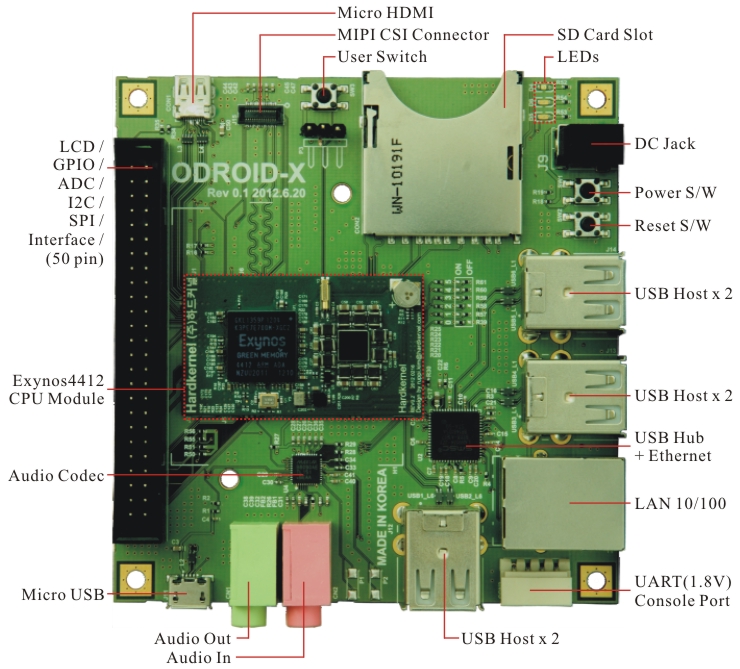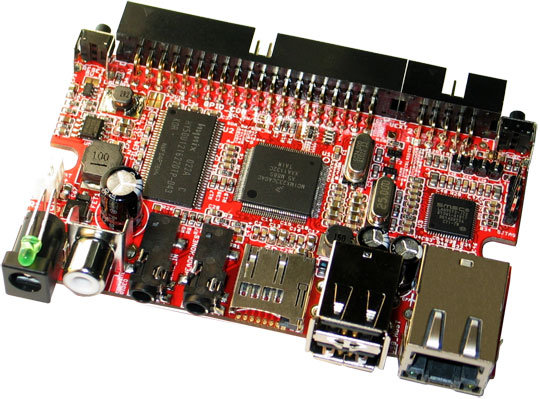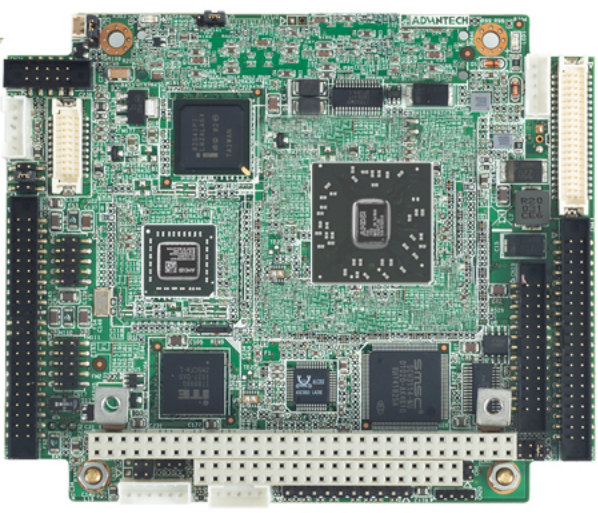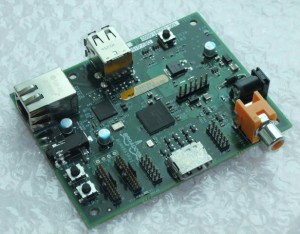HardKernel unveiled the ODROID-X development board based on Samsung Exynos 4412 quad-core ARM Cortex-A9 with quad core Mali-400 GPU, 1 GB Low Power DDR2 and storage is done via SD card and/or eMMC flash. Here are ODROID-X development board specifications: Processor Samsung Exynos4412 Cortex-A9 Quad Core 1.4Ghz with 1MB L2 cache Memory 1024MB(1GB) LP-DDR2 800MB/s data rate GPU Quad Core Mali-400 Video supports 1080p via HDMI cable (H.264+AAC based MP4 container format) Video Out micro HDMI connector / RGB-24bit LCD interface port Audio Standard 3.5mm headphone jack and microphone jack HDMI SPDIF LAN 10/100Mbps Ethernet with RJ-45 Jack (Auto-MDIX support) USB2.0 Host High speed standard A type connector x 6 ports USB2.0 Device ADB/Mass storage(Micro USB) UART System console monitoring for development (1.8volt interface) IO PORTs 50pin IO expansion port for LCD/I2C/UART/SPI/ADC/GPIO interfaces Display (Option) HDMI monitor / LCD panel with RGB or LVDS interface Storage (Option) Full size SDHC […]
Olimex Offers Up to 50% Discount on OLinuXino Boards to Open Source Developers
Olimex has been providing low cost MCU devkits for many years, and this year they started offering more powerful embedded Linux development boards called OLinuXino. The first family (iMX233-OLinuXino) is based on Freescale i.MX233 ARM9 processor @ 454 Mhz and comes in three form factor: iMX233-OLINUXINO-MAXI – 2x USB host, Ethernet, TV-out, GPIOs, SD-CARD, Audio-In, Audio-Out, UEXT – 44.95 Euros. iMX233-OLINUXINO-MINI – 3x USB host, TV-out, GPIOs, SD-CARD, Audio-In, Audio-Out, UEXT – 34.95 Euros iMX233-OLINUXINO-MICRO – USB host, TV-out, GPIOs, SD-CARD, ready for breadboaring – 23.95 Euros They are also working on A13-OLinuXino board featuring AllWinner A13 Cortex A8 processor. To promote their new boards (and reward open source developers – cf comment below), the company company has decided to offer discount to open source developers. The way I understand it: you need to buy a board first, publish the source code somewhere and write about it on your own […]
Quick Binary Debugging in Linux with Strace System Call Tracer
I’ve recently come across strace, a debugging utility for Linux that “monitor the system calls used by a program and all the signals”. It may not be that useful if you have the source code and can run other debugging tools such as gdb, or simply add printf to your code. But if you don’t have source code of the program, or you are a system administrator who wants to check if the program fails due to file access reasons, for example, this is really a great tool as it may help you find out which file causes problem. In my case, I was trying OpenGL ES on an ARM platform, and at least part of the code comes in libraries that are only available in binary form. I got the following error message running es2_info (part of mesa-utils-extra): UMP: ump_arch_open() failed to open UMP device driver ********************************************************************* ERROR: In […]
AMD Introduces AMD G-T16R G-Series APU with 2.3 Watts Power Consumption
AMD has unveiled another APU in its Embedded G-Series processor family with the AMD Embedded G-T16R, which aims to provide a more powerful (up to 3x) and less power-hungry (7% less) replacement to AMD Geode LX processors. The AMD G-T16R is targeted at very low power, small form factor and cost-sensitive embedded designs. The company claims the processor consumes about 2.3 watts on average or 4.5 watts thermal design power (TDP). This new AMD embedded processor targets industrial control, point-of-sale, medical appliance and transportation markets. As with the other G-Series platforms, the G-T16R can fit into small form factor boards by implementing a two-chip platform: APU + controller hub. AMD G-T16R is clocked at 615MHz, features a Radeon HD 6250 GPU and supports 1920×1200 resolution via VGA, single link DVI and DisplayPort 1.1a video outputs. It can also output 1080p via HDMI and LVDS. The APU supports Windows Embedded Compact […]
List of 39 Low Cost Linux Friendly Boards and Products
Dmitry (omgfire), one of my awesome readers, compiled a great tabular list of Linux friendly boards and products that sells for less than $300 US (usually less than $200). This list includes technical details such as the processor, GPU, memory, NAND flash, connectivity, ports, supported Linux distributions… as well as availability and pricing information. There are currently 39 Linux devices in total. The vast majority are ARM based boards, but he also included 2 x86 products by VIA, but those are relatively pricey ($265 and up). Here’s a summary list with SoCs used, links to blog posts and product pages (if available), as well as price information. Raspberry Pi Model B – Broadcom BCM2835 (ARM11) – Blog post (That’s my first post about the R-Pi last year, and the board is much different now) – Product page – Price: $35 + shipping Rikomagic MK802 – Allwiner A10 (Cortex A8) – […]
The Future of ARM Linux by David Rusling, Linaro CTO
David Rusling, Linaro CTO, gave a presentation about the future of ARM Linux at Linaro Connect, in Hong Kong, at the end of May, where he discussed the current status of ARM Linux for mobile, consumer and enterprise markets, the future of ARM Linux and Linaro involvement. He started by saying what he wants personally: A mobile phone that can’t be easily hacked, with 10 hours of battery life for any kind of applications and data must be synchronized in the cloud. The second slide entitled “Future”, but it looked like more the present to me, addresses 3 markets: Mobile: Android vs. iOS, although Windows 8 is coming Post PC: The desktop fades and laptop/tablet merge (think Asus Transformer) Enterprise: Cooling and Power is key and the enterprise is ready for innovation, meaning it will start using ARM platforms. He then focuses on Linux explaining that Android has been the […]
Collabora and Fluendo Release GStreamer SDK 2012.5 Amazon
Last week, Collabora and Fluendo jointly announced the release of an open source software development kit (SDK ) for GStreamer multimedia framework. The SDK aims at easing the integration of Gstreamer into projects and provides a pre-built version of the framework which is available for Linux, Windows and Mac OS X. GStreamer is used in many Linux applications such as media players (Rhythmbox, Banshee and Amarok), video editors (PitiVi), and media centers such as XBMC among other applications. It’s also often the framework used to play videos on ARM platforms with implementations for OMAP 4/5 and devices compliant with the OpenMAX standard. Gstreamer website has also been updated and provides links to download GStreamer SDK and documentation on the home page. The new documentation looks pretty good with fives main sections: Instructions for installing the SDK on Linux (Ubuntu, Debian and Fedora), Windows or Mac OS. 11 basic and 2 advanced tutorials. […]
Hardware Packs for AllWinner A10 Devices and Easier Method to Create a Bootable Ubuntu 12.04 SD Card
Linaro has a tool called linaro-media-create to install Linaro Ubuntu to an SD card by passing the device, hardware pack file, the rootfs and the board as arguments. Hardware packs are files that contains hardware specific binaries and configs files (e.g. bootloader, kernel…). I’ve done something similar (albeit more basic) for AllWinner A10 devices so that you can easily install and run Ubuntu (and possibly other distributions) on an SD card. I’ve written 2 scripts for this: a10-hwpack-bld.sh – Script to generate evb.bin, build the latest u-boot and linux kernel, retrieve some config files and compress all this in an hardware pack file a1x-media-create.sh – Script to make a bootable SD card for AllWinner A10 devices. You can get the scripts with git:
|
1 |
git clone git://github.com/cnxsoft/a10-tools.git |
I’ve only tested it with Mele A1000, but if you have other A10 devices such as MK802 mini PC or MINI X media player, it should […]







